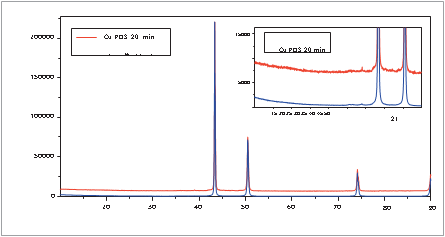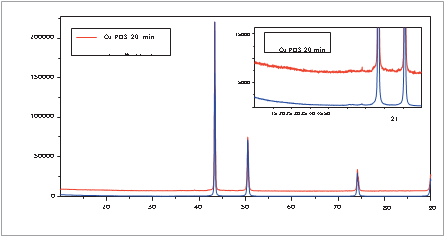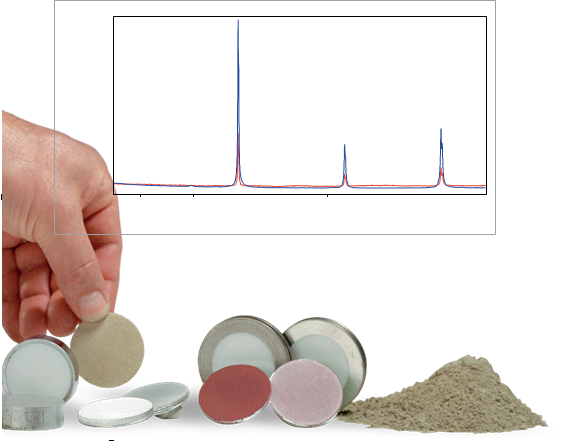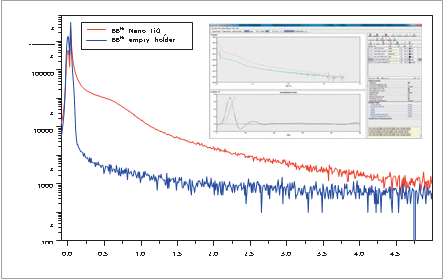With the introduction of Bragg-BrentanoHD, Malvern Panalytical again sets a new standard for recording high-speed, high-quality powder diffraction data, with the following key features:
1. Excellent monochromatization of the radiation from the X-ray source, with the following benefits:
2. Extends the range of applications of the powder diffractometer without the need for additional modules
3. Compatible with all Malvern Panalytical multipurpose powder diffractometers, both on new systems and already installed ones
Please login or register for free to read more.
Figure 1: Comparison of two data sets recorded on NIST SRM1976b. For both measurements, the optics settings were chosen to create matching peak shapes. The red data set was recorded with a conventional programmable divergence slit (PDS) set to 1/4°, the blue data set (recorded with a Bragg-BrentanoHD) shows a higher intensity and lower background.
With the introduction of Bragg-BrentanoHD, Malvern Panalytical again sets a new standard for recording high-speed, high-quality powder diffraction data, with the following key features:
1. Excellent monochromatization of the radiation from the X-ray source, with the following benefits:
2. Extends the range of applications of the powder diffractometer without the need for additional modules
3. Compatible with all Malvern Panalytical multipurpose powder diffractometers, both on new systems and already installed ones

Figure 2. Same sample as in Figure 1. A scale factor of 1.96 was applied to the data recorded with the divergence slit in order to match the tops of the strongest peak. In the measurement recorded with Bragg-BrentanoHD, the peak-to-background ratio is 3 times higher, and the overall background is lower, making the visibility of weak reflections (e.g. the (202) reflection near 46° 2θ) better.

Figure 3. A measurement with slit optics and a beta filter (red) on a Cu-rich sample shows a very high background due to fluorescent radiation from the sample. With Bragg-BrentanoHD (blue), this fluorescent background is completely absent. The insert shows a detailed view of the background. The presence of a beta filter- induced absorption edge in the slits measurement is visible close to 42 ° which is absent in the Bragg-BrentanoHD data set. In the latter, the residual Kβ peak (near 39 °) is much lower, and one can also see tiny peaks from a contamination in the sample between 35 ° and 37 °, which only become visible in the scan with slit optics after a much longer scan time.

Figure 4. A high concentration of Fe in a sample is known to result in an increase of the background level. Also here, a good peak-to-background ratio (red) can be obtained by optimizing the lower level of the pulse height discriminator. Alternatively, a 1D diffracted beam monochromator can be used. For iron-rich samples, the use of cobalt radiation is a much better choice. The peaks are more intense, and an excellent peak-to-background ratio is achieved with Bragg-BrentanoHD setup for Co radiation (blue scan).
Figure 5.Comparison of reflectograms from a 50 nm thick iridium layer deposited on top of a silicon substrate. Excellent data can be obtained with Bragg-BrentanoHD; there is no need for a separate diffracted beam monochromator or a parallel beam mirror.

Figure 6. Small angle X-ray scattering (SAXS) data collected using Bragg-BrentanoHD. In red, the scattering curve from the sample and in blue the background from the holder. In the inset, the analysis of the data performed with the EasySAXS software is shown, resulting in a particle size of 4.4 nm, as expected for this sample.
| Bragg-BrentanoHD | Incident beam PreFIX module |
| Used with | Cu radiation (version for Co radiation available upon request) |
| Energy resolution | <450 eV |
| Cu Kβ suppression | Remaining Kβ <0.2% Kα |
Bragg-BrentanoHD sets the standard for the fastest recording of powder diffraction data with a low and smooth background. Bragg-BrentanoHD maximizes the throughput in the laboratory, while minimizing the chance for misinterpreting trace features in the data.
The same optic can be used for high-quality measurements on thin films (layer thickness) and nanomaterials (particle size distribution analysis)
Bragg-BrentanoHD is available for new Malvern Panalytical instruments, and can be retrofitted to already delivered multipurpose diffractometers equipped with PreFIX.